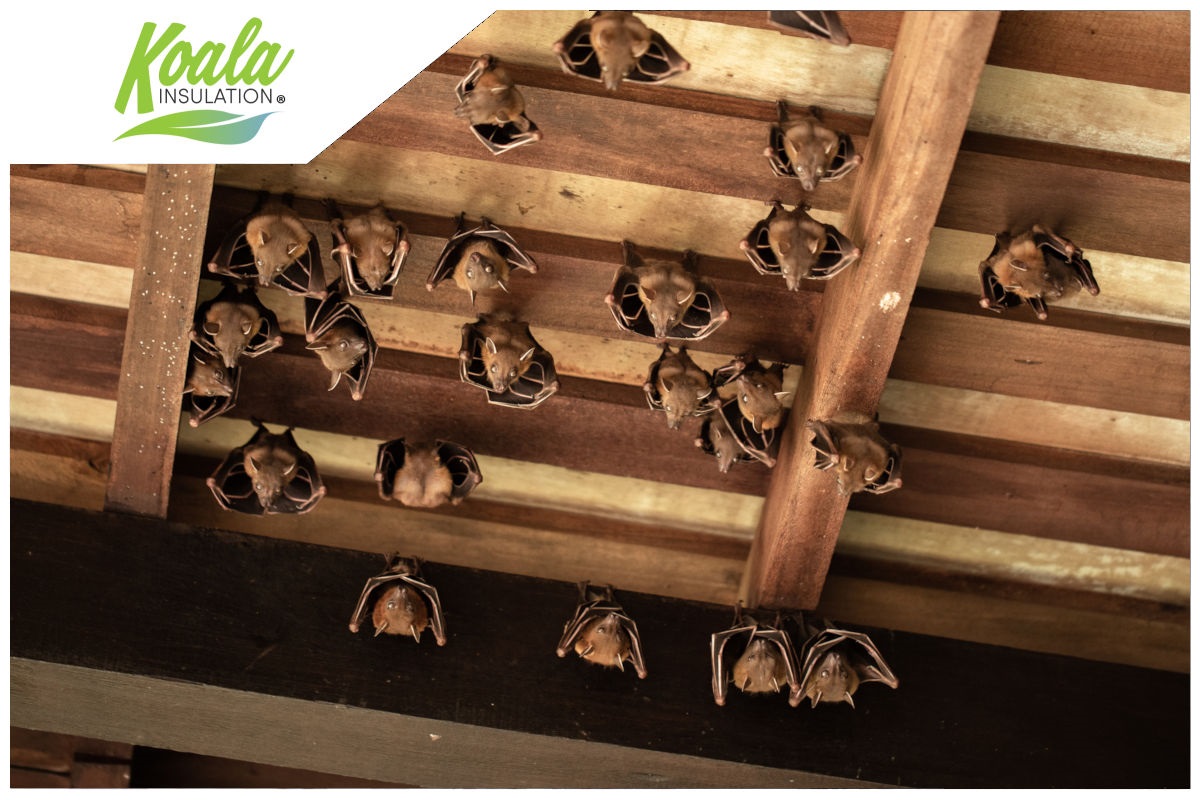Here’s Why You Need Insulation Replacement

Squeak, squeak, rustle . . . do you hear that? If you notice sounds coming from above your head at night, or in quiet moments during the day, your first assumption may be that your house is suffering from a rodent infestation. While that could be the case, there’s another possibility: it may be that you’ve got bats in your attic.
When homeowners discover that they are unexpectedly sharing their living space with a colony of bats, they typically have a lot of questions about what can and should be done, how their home may have suffered damage as a result, and how to prevent it from happening again in the future. One of the biggest concerns that some homeowners aren’t aware of is that having bats in an attic does serious damage to attic insulation. That’s why it’s so critically important to have insulation removed and replaced after removing bats from your attic.
If you have just gotten pest removal services or you’re currently working on evicting your unwanted “tenants,” count on the team of Kansas City insulation professionals at Koala Insulation of South Kansas City to take care of removing your old, damaged insulation and replacing it with brand-new, fresh, energy-efficient material so you can rest easy knowing your home is properly protected from heat transfer and other issues that can make it less comfortable and hospitable for you and your family.
Do Bats in an Attic Have to Be Removed?
Unlike rodents, some people aren’t all that troubled by the presence of bats in the attic. They don’t tend to invade the other parts of your house the way rats or mice do, and they give homeowners the opportunity to make plenty of dad jokes about having bats in the belfry. As cute and intriguing as those little flying critters can be, they are still wild animals and aren’t compatible enough with humans to safely share a living space with us.
The accumulation of guano, or bat excrement, is the biggest problem that comes along with having bats in the attic. Kansas City, MO homes can suffer from problems like flattened, deteriorated, moldy insulation that reduces the energy efficiency of the house, and the house can even incur structural damage if there’s bats in the attic for an extended period of time. Guano also poses a human health risk because it hosts a fungus, histoplasma capsulatum, that can cause a respiratory infection called histoplasmosis. That’s why it’s important to call a pest control service to get bats in your attic safely removed so they can flutter off and live their lives in a more appropriate location.
Can Bats in an Attic Be Exterminated?
If you’re used to getting rid of rodents with extermination methods like traps or poison, you may be wondering if you can just do the same to get rid of your bats in the attic problem, but that’s not an option. It’s actually illegal to kill bats in the United States, for some very good reasons. Some species are federally protected because they are endangered, but there are also state-level regulations designed to protect bats from harm. They provide some major benefits to humans, such as insect control. In fact, one single bat can consume an astonishing 3,000 insects in a night—and mosquitoes are among their favorite foods.
Humane bat removal isn’t just the right thing to do, it’s also a legal requirement. One of the most effective ways to evict bats in your attic without harming them is with a bat exclusion device. That involves finding their entrance point into the attic space and fitting it with an exclusion gate. The gate allows bats to leave the attic to feast on night-flying insects, but they’re unable to get back in afterward and must find a more suitable place to roost. As simple as this process may sound, there are some potential pitfalls. It’s important to get the timing right so you don’t trap juvenile bats that are unable to fly, for example, so it’s best to consult with a bat exclusion expert.
Is It Necessary to Replace Insulation After Removing Bats From Attic?
If you got one little confused bat in your attic and quickly ushered it back outside where it belongs, there’s probably not much damage to insulation. But if there was a colony roosting up there, we can say with confidence that you do need services for insulation removal and reinstallation.
In an attic space, insulation typically covers the “floor” of the attic (which is usually the upper side of the ceiling for the story underneath, not a real floor). It’s done like that to prevent heat transfer between the attic and the story below, while at the same time allowing air to circulate freely inside the attic space to prevent condensation build-up that can lead to severe moisture damage.
Since the insulation is exposed on the floor of the attic, it will be flattened and damaged by the accumulation of guano, which dramatically degrades its effectiveness by lowering the R-value of the insulation. Bats may also burrow into insulating material during the winter because they are attracted to the warmth rising up from the ceiling of the story below the attic, and needless to say, that also causes damage to insulation and lowers its ability to effectively prevent heat transfer. And, since the insulation is contaminated with guano, it will mold and can pose a health risk to your household—not to mention smell pretty terrible.
How Does Damaged Attic Insulation Affect a Home?
Many homeowners tend to take their insulation for granted, and have never given much thought to why it’s there and what exactly it does. While we all know how insulation works on a basic level, it can be helpful to understand exactly how deteriorated, flattened insulation in your attic can impact the comfort and hygiene of your house—not to mention force you to pay more than necessary on your monthly utility bill.
Increased Energy Costs
Have the energy costs on your monthly bill increased recently, even though you haven’t changed your routines and should be using around the same amount of energy as usual? There’s a number of factors that can cause a house to lose energy, but if you’ve just dealt with bats in your attic, damaged attic insulation is the prime suspect.
Heat transfer is a natural process in which thermal energy tries to move from a warmer place to a colder place—like when heat from your furnace escapes outdoors during the winter, or heat from the sun seeps into your house in the summer while you’re running the air conditioner. Heat transfer compromises the efforts of your HVAC system so it has to operate for longer periods of time to compensate, using more electricity or natural gas, and that additional operation time really adds up on your energy bill.
Insulation is designed to prevent heat transfer, and a home that is properly insulated can save a surprising amount of money on energy costs by making it easier for your hard-working HVAC system to keep your house at the temperature you have set on your thermostat. As we learned in elementary school science class, heat rises. That means attic insulation is particularly important, because without it, heat will simply rise up to the attic and escape through the roof—or the sun beating down on the roof will let summer heat spread through the entire house.
Less Comfortable and Hygienic
Your bank account isn’t the only thing that can be affected by deteriorated insulation caused by bats in your attic. Flattened, ineffective insulation can let in drafts that will make your home less comfortable for the members of your household. It can also give off unpleasant odors that no one wants wafting through their house, especially on a warm day when it’s baking hot in your attic and the smell is much stronger than usual.
Can My Pest Control Company Take Care of Insulation Replacement?
It makes sense to call a pest control company to deal with a task such as removing bats from your attic—that is their area of specialization after all, and they have the right equipment and know-how to get the job done correctly. However, some pest removal businesses will also offer to remove and replace your attic insulation for an additional charge, and that is not their specialization. Just like it takes skill and experience to handle pest removal safely, it takes skill and experience to remove and install insulation to the highest standards of workmanship so you get the best possible results.
Some homeowners assume they’ll get a better price for insulation work from their pest removal company because they can take care of the whole process all at once. However, the opposite is usually true. In most cases, you can actually get a better rate from the team of insulation experts at Koala Insulation of South Kansas City. Not convinced? If you’ve already received a quote for insulation work from your pest control company, give us a call. We’ll come to your property and take a look at your attic in person, review the recommendations you were given and offer a professional second opinion on what needs to be done, how it should be handled and how much it should cost so you can make an informed decision about what’s best for the care of your home—and your bank account.
How Do Bats Get Into an Attic?
Now that you know more about how bats in your attic can affect insulation and make your home less energy efficient, you may be wondering how they even got in there in the first place. Rats and other types of rodents like mice and squirrels are well-known for chewing their own entrances in a house when they want to get inside, but bats are not chewers. In fact, they’re not even rodents—they’re both mammals, but rodents belong to the order Rodentia, while bats have their own order called Chiroptera. So if they don’t chew, how do they do it?
Bats are opportunistic creatures that take advantage of existing holes or gaps to get inside your warm cozy house. A potential entry could be a broken attic vent, a loose fascia board, a jammed chimney flue, a cracked soffit or other areas of damage near your roof or attic walls. Needless to say, it’s really important to find those gaps and make sure they are properly closed up so the problem doesn’t simply repeat itself in the future.
Trust the Experts at Koala Insulation to Remove and Replace Attic Insulation
Kansas is home to 15 species of bats, which means homeowners and business owners alike may find themselves dealing with an infestation of bats in the attic of their residential or commercial properties. Getting those critters out of your house is only the first step—once they’re gone, it’s critically important to get your old, damaged insulation taken out and have new insulation installed.
Count on the team of professionals at Koala Insulation of South Kansas City to take care of attic insulation removal and reinstallation quickly and effectively. Whether your attic space needs blown-in insulation or batt insulation, you can rely on us for expert workmanship and customer care that goes above and beyond.
Contact us today by picking up the phone and calling 816-929-8255 to find out more about our trusted insulation services, or to schedule an appointment so we can come by and give you our best recommendations for what needs to happen next to restore the comfort and efficiency of your house. Insulation is our specialty, and our experienced team has the knowledge and skill to handle removal and replacement properly so you can have the peace of mind that comes with knowing your home is protected and functioning as it should.
Find Your Location


Get a quote



